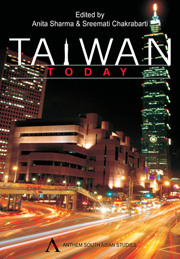Book contents
- Frontmatter
- Contents
- Acknowledgements
- Contributors to this Volume
- Acronyms and Abbreviations
- Foreword
- Introduction
- 1 Who are We? Identity in Transition
- 2 Taiwan: Yearning for an Identity
- 3 The Implications of Direct Flights: Beijing in Taiwanese Politics
- 4 Kuomintang, Democratization and the One-China Principle
- 5 The Deepening and Consolidation of Democracy in Taiwan
- 6 India and Taiwan: Bolstering Complementarity in Information Technology
- 7 Asian Regional Economic Integration and Taiwan–India Economic Relations
- 8 The Taiwan Factor in Sino–Indian Relations
- 9 Japan's Triumphant Diplomacy in Taiwan in 1874
- 10 A Study of the Cultural and Educational Exchanges between Taiwan and India, 1995–2006
- 11 Between Two Worlds: A Survey of Education in Taiwan
- 12 Female Immigrants, Social Capital and Public Sphere in Taiwan
- 13 Information Technology and Gender: Taiwan and India
- 14 Tzu Chi: A Case Study of Engaged Buddhism in Taiwan
- 15 Master Hsing Yun of Fo Guang Shan and the Development of Humanistic Buddhism
- 16 The Heritage and Innovation of Chan Paintings in Taiwan
- 17 Taiwan in World Architecture: A Historical Perspective
- Afterword
Introduction
Published online by Cambridge University Press: 05 March 2012
- Frontmatter
- Contents
- Acknowledgements
- Contributors to this Volume
- Acronyms and Abbreviations
- Foreword
- Introduction
- 1 Who are We? Identity in Transition
- 2 Taiwan: Yearning for an Identity
- 3 The Implications of Direct Flights: Beijing in Taiwanese Politics
- 4 Kuomintang, Democratization and the One-China Principle
- 5 The Deepening and Consolidation of Democracy in Taiwan
- 6 India and Taiwan: Bolstering Complementarity in Information Technology
- 7 Asian Regional Economic Integration and Taiwan–India Economic Relations
- 8 The Taiwan Factor in Sino–Indian Relations
- 9 Japan's Triumphant Diplomacy in Taiwan in 1874
- 10 A Study of the Cultural and Educational Exchanges between Taiwan and India, 1995–2006
- 11 Between Two Worlds: A Survey of Education in Taiwan
- 12 Female Immigrants, Social Capital and Public Sphere in Taiwan
- 13 Information Technology and Gender: Taiwan and India
- 14 Tzu Chi: A Case Study of Engaged Buddhism in Taiwan
- 15 Master Hsing Yun of Fo Guang Shan and the Development of Humanistic Buddhism
- 16 The Heritage and Innovation of Chan Paintings in Taiwan
- 17 Taiwan in World Architecture: A Historical Perspective
- Afterword
Summary
Today East Asia is undoubtedly the most dynamic region of the world in terms of economic growth and development. The 1980s economic boom in East Asia drew the world's attention towards it. The ‘Four East Asian Tigers’ (South Korea, Singapore, Hong Kong and Taiwan), as they were called, ceased to appear like developing areas as they achieved phenomenal success in their growth-oriented strategies and effectively advanced the standard of living of their people. In India, Taiwan began to be noticed and its outstanding economic performance appreciated, both among the government and non-government circles.
Soon after independence, India's international overtures indicated that it wished to have close ties with the entire Asian and African region. In the post-cold war period this has been revived in some form. India's diplomatic relations with the People's Republic of China (PRC) rules out any possibilities of political ties with Taiwan. However, in the mid 1990s the Indian establishment's ‘Look East Policy’ widened the arena for a multidimensional relationship with the various entities in the East Asian region. In 1995, both India and Taiwan set up ‘Economic and Cultural Centres’ in Taipei and New Delhi. Economic relations had been growing much before this but with the setting up of these centres, people-to-people contacts have been increasing with each passing year. In the sphere of economic ties there is great scope for expansion particularly in the Information Technology (IT) sector.
- Type
- Chapter
- Information
- Taiwan Today , pp. 1 - 5Publisher: Anthem PressPrint publication year: 2010



